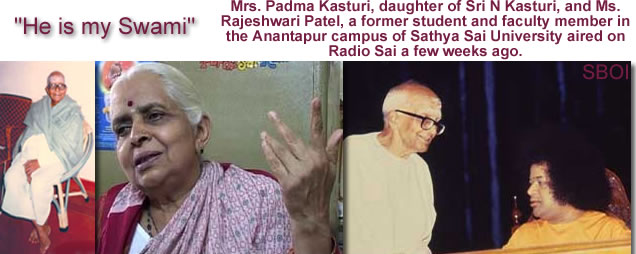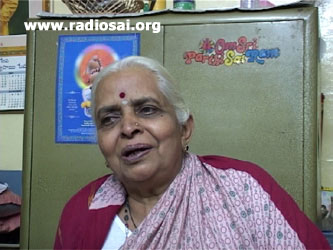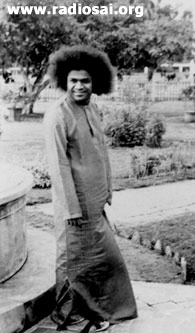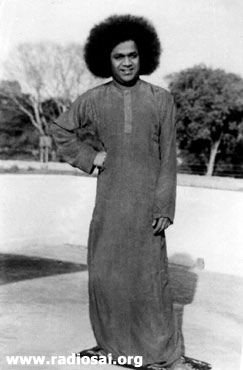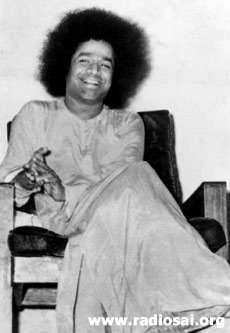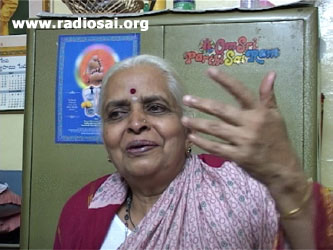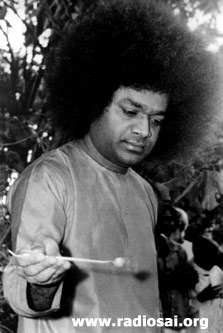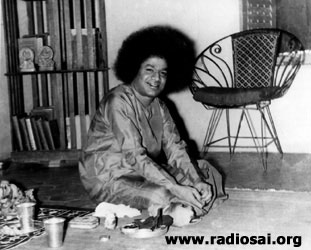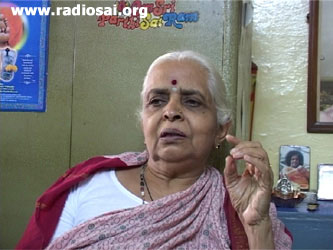|
"He is my swami" |
||||||||||||||||||||||||||||||||||||||||||||||||
|
Rajeshwari Patel (RP): Aum Shri Sai Ram! Welcome to Radio Sai Global Harmony. Mrs Padmamma is once again with us today to share some more of her own memorable experiences with Beloved Bhagavan. Welcome Ma’am to the studio of Sai Global Harmony. Padma Kasturi (PK): Thank you Rajeshwari. RP: Last time when we met here, after the interview (in which you spoke very fondly about your father) as we were going together, I asked you if I should walk you back to your house - as it was late - and your reply on that occasion still rings in my ears. You said: “No! This is my Prashanti Nilayam! I know the place better than you.” I felt a joyous sense of belonging in your voice. I realized that your life is so very much tied to Bhagavan and to this place. So, I would like to begin this session with a question relating to this. Please tell our listeners about ‘your Prashanti Nilayam’ as you called it. What was it like in those days? What was the daily routine?
PK: Yes, with all the baggage going through the sands…
RP:
So you had to cross the hot sands?
RP: So how
many hours of journey is it from Bangalore to Puttaparthi with all these
different stops?
PK: We started Bangalore at 9 o’clock in the morning and we used to reach Puttaparthi by 5 or 6 in the evening. And the best thing was that Swami would be there waiting for us. Whenever any bullock cart would come, He would be near the bullock cart to receive us. RP: Oh! So He was giving you a very warm welcome!
PK: Yes, then
we never felt hot from the journey at all! We would get His
namaskar (chance to touch His
feet) immediately and if there were any small children in the bullock
cart, He would Himself hold them and take them out of the cart and would
immediately come to the house and even ask us: “What have you brought for
Me?” like a small child – a relative - you know! PK: He always knew of course, but whenever some bullock cart came, He was always there to receive. So it was always a wonderful experience coming to Puttaparthi.
RP: So everybody got an interview? PK: Everybody got an interview mostly. And we would make sure we got the interview the day we left because then we could take the prasadam too. RP: On a regular basis, how many people used to be there everyday on an average? PK: Average about 200 to 300, that’s all. RP: Everyday? PK: Yes, everyday. RP: But on festivals? PK: Oh! On those festive days the Mandir hall would be full! We used to say: “Oh! So many people! The hall is full!” and now everyday the hall is full! RP: Yes, more than full! So there was no routine as such?
RP: What time? PK: It was in between 6 and 7. RP: Oh! Were there interviews in the evening too? PK: No, not many. Interviews were in the morning mainly or during bhajans – as He wished. It was not a planned routine like these days. RP: So He was literally the Master of the place! PK: Yes. So anyway, since we didn’t have electricity, we had to draw water from the wells – there were two wells there – and we ladies used to gather between 4 and 6 in the evenings and we used to water the plants. Some strong ladies used to draw the water and we young ladies used to stand in lines and pass on the water pots from one to another. And some old ladies who could not carry the water, used to collect the empty vessels and put it away. It was a daily routine, from 4 to 6. RP: So only the women did the watering of the plants? PK: Yes, and Swami used to sometimes walk around in the garden, and come and talk to us and after the watering would be done, sometimes He used to give us some fruits or some other prasaad – so we would really enjoy it. RP: You know, last time when you were talking about your father, you were saying that you were unfortunately not present when Bhagavan was going to take a picture of your father; and the photograph, of course, turned out to be a joke that He wanted to play on Prof. Kasturi. Were you at any time ever involved in any similar kind of incident?
RP: Was he holding the pot too? PK: Yes, a small pot. Then the problem was, there was only one photographer in Puttaparthi and he was a young man. Swami didn’t want some young man to come and photograph all these young ladies, so he asked my father to come and take a picture. My father said: “Swami! I don’t know how to focus or to even hold the camera!” RP: So Swami didn’t even want the young photographer to look through the camera-box and take your picture? PK: Yes. Then Swami said: “No! Don’t worry. I will help you with the focusing of the camera and I will show you everything. You just hold the camera; I will come back and sit on the pot and when I say ‘ready’, you just click!”
Dinners by Moonlight! PK: Yes. RP: I heard that you had several opportunities to have moonlit night dinners with Bhagavan? PK: Yes. RP: Please tell us about that! PK: Swami liked moonlight dinners very much. Whenever it was a full moon day, He would ask everybody: “Oh, let’s just go and have dinner in the open Mandir terrace!” RP: Oh! Mandir terrace? What about the sands of the River Chitravati? Did He take people there too? PK: No. These dinners were usually just on the terrace.
RP: Oh!
That’s good. So these were terrace-dinners? RP: What were the favourite dishes of Swami? PK: Oh, some wadas or bhajis. RP: He liked that?
RP: Were they mythological ones? PK: Yes, mythological ones. RP: I am sure you all liked that! PK: Yes. And after dinner would be done, we would do aarti to Swami. Once, He asked for an empty plate. Somebody gave Him an empty silver plate. He just hit the empty plate from the bottom and the whole plate was full of vibhuti! RP: Oh my God! And then He gave it to all of you? PK: Yes, He gave it to all of us. And we enjoyed the opportunity! I think I had these moonlight dinner parties at least twice or thrice; all are memorable! RP: With all these old songs playing in the background! That must be fun! What about on Ekadashi days? Were you with Bhagavan when He created amrita (nectar) and all that? PK: Yes! I was with Him many times – 3 or 4 times at least. There was one special Vaikuntha Ekadashi. It was in 1957 – I remember that year because Swami celebrated my father's 60th birthday in the Mandir that year. And because my father was born on Christmas day, it was in December; and Vaikuntha Ekadashi usually falls in the end of December too. Swami took us all to the Chitravati River and said: “We will have moonlight dinner at Chitravati!” - It was very rare but sometimes we would have it. We all prepared food and took it there and Swami did some bhajans. RP: And the petromax lamp was taken along too? PK: Yes. We took that because by the time we would return, it would be dark and late; so we took torches because the roads were not like what they are today!
RP: We have heard about Him taking the linga out from within but this is something rare! PK: He would take out some things from a silver tumbler or silver container or sometimes He would take out a conch-like thing from the sand and He would pour amrita from that container. But this time He took it out from His mouth. And He asked my father: “Have you noticed what is there in My stomach? It is the amrita-kalasha (vault of nectar)!” RP: Oh! He said that? PK: Yes! RP: So the nectar container is in His stomach! PK: Yes. I think we were all very fortunate to get the real amritam from Him. A real amrita-kalasha! RP: And that too from Maha-Vishnu! And that too on such an auspicious day! PK: Yes. And He gave it too all. He never used to give amritam in our hands. He would pour it Himself in our mouth with a spoon! It was really difficult because we had to open our mouth wide right in front of Swami! RP: And then He would pour it! That’s good. Now, do you have any mementos of those early years? Reviving the Ancient Temples PK: Yes, I do have some. In 1954, for Shivaratri, Swami created 9 shivalingas and they emerged from His mouth; they were small but He had given one to my grandmother and she used to worship it and do abhishekam. RP: So is that with you? PK: Yes, that’s with me now. RP: Do you then also do the abhishekam? PK: Yes, I worship it everyday and do abhishekam. RP: So that’s the legacy that you have! PK: And you would also know that when Swami went to Badrinath, He took out the lingam from the shrine which was installed by Shakaracharya and the lingam was worshipped with golden bilva leaves created by Swami. RP: Yes, we read about that in Sathyam Shivam Sundaram.
PK: Yes, He created one for me in 1954 when I had some problems in my life. He said: “I will give you this picture and whenever you are in agony or despair, you can pour out your sorrows in front of this picture and I will give you solace and peace.” RP: So you have that too? PK: Yes. The Creator Demonstrates the Missing Link RP: That’s great! What else do you have that He maybe gave to your father that you have now? PK: See, we have heard of Swami creating rings, lockets, vibhuti etc. but once, He created a small monkey! Not a real monkey but a stone monkey for my father. Would you like to hear about it? RP: Yes! Please tell us about it because that is very unusual. What was the occasion? PK: It seems one day there was some discussion about the evolution of man - Darwin’s theory - with Swami and some devotees there and since my father was an Anthropology Professor, he was very interested in it. RP: Oh! So he was in anthropology too? I thought it was just history! PK: No! He was in Anthropology too. He was studying it and so he was interested. RP: So he was an expert then?
PK: Yes. He
started telling Swami: “Swami, I know Anthropology and the evolution of
man and all that!” then he said: “Swami, the monkey would live on the
ground. They are so near to the man in evolution.” PK: Yes, the closest. Then Swami said: “No! There was one species of monkeys that used to live on the trees but had no tail; they were the closest relation to man.”
PK: It was a stone; brown colour not dark brown but beige - kind of a biscuit colour. It was sitting with a fruit in its hand and it was without a tail; but the eyes were so expressive. RP: Is that with you now? PK: No. Father said it would be better if it was kept in a museum so that people can see too. If it was at home, then only those who come to our home can see it. So I think it’s in the University Museum. I also have some mementos of letters which Swami wrote to me. (To be continued...) - Heart2Heart Team
|
||||||||||||||||||||||||||||||||||||||||||||||||
